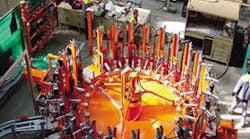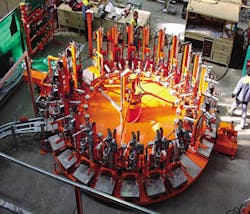Gas cylinders have become a staple of recreation. And whether you use them in your gas grill, camper, or boat, eventually, they'll have to be refilled. One solution is to take your empties to your neighborhood dealer, who will refill them manually on the spot.
But many people take their empty cylinders to a retailer that exchanges the empty cylinder for a full one - and for a fee, of course. This is the norm in Europe. But in Europe, gas cylinders vary in size, shape, and valve configuration depending on the country in which they are used. This variety of geometries can complicate automated refilling processes unless the cylinders are presorted. But manual sorting defeats the advantages of automated refilling. Moreover, cylinders also must be inspected to assess their condition. Condition of empty cylinders varies from nearly new to rusted, dented, or otherwise unserviceable. And some cylinders aren't even empty - they could be half-full or more.
Pneumatics goes international
Officials at Siraga, Buzan Vais, France, know the challenges gas retailers face with the different types of cylinders. Siraga designs and manufactures machines for companies that fill the cylinders with liquid butane, propane, and other gas. With export sales of nearly 80% Siraga is a world leader in this field. Depending on the machine's specific features, Siraga relies on pneumatics for safe, reliable, precise, and high-speed operation.
Siraga designs each machine based on a customer's specific requirements, ranging from a simple filling apparatus right through to a large filling plant. A major consideration is the number of cylinders to be filled. In France, for example, 800 to 1000 bottles may be filled per hour. In Asia, machines may process up to 1200/hr. And in South America, filling rates may reach 2200/hr. In addition to this variety of filling rates, cylinder weight can vary from between six to 110 kg, and lengths may range from 400 to 1200 mm.
Siraga's project design specialists strive to build standardized machines that can accommodate all the variations in size, geometry, and valve type. All cylinder centering devices are the same, for example. And wherever possible, standard valves, air cylinders, and other components and sub-assemblies are used.
Positioning via air cylinders
The circular conveyors of a typical filling plant are fitted with eight to 36 filling stands. The cylinders are inserted, transported, and removed automatically. The gas distribution system is situated in the center of the circular conveyor. This is where the butane, propane, or other gas flows through tubing to the individual filling stands. The gas cylinder valves can be automatically or manually connected and opened, removed and sealed.
Siraga uses at least 40 pneumatic cylinders from Bosch Rexroth in each of the filling installations. These cylinders are used to center the gas bottles prior to and during filling and remove them from the conveyor after they have been filled.
Safe and standard
Because it is imperative that no positioning problems occur when handling the liquid gas, one cylinder is dedicated to every filling stand as safety precaution. Furthermore, a pneumatic cylinder also opens the fill valve on each gas cylinder. Siraga also compensates for the different bottle sizes within the circular conveyor by using pneumatic cylinders.
As with most components of the circular conveyor, standard pneumatic cylinders are specified. This enables an installation to remain in operation by avoiding delays from hard-to-find components. Most ISO cylinders used in the design are double-acting to enhance speed and control and are fitted with magnetic sensors for electronic position sensing and control. Most also incorporate pneumatic cushioning to promote component longevity.
Tough demands
Because a typical application frequently involves aggressive environmental influences and high humidity, Siraga places great emphasis on the specific cylinder materials. Anode-oxidized cylinders made of electrically zinc plated aluminum profile are used to prevent corrosion. The piston rod also is made of non-corrosive material. The load, the speed of the circular conveyor, and its dynamic forces all determine cylinder design, with Siraga accounting for the high demands and still placing emphasis on safety and selecting slightly over-dimensioned cylinders.
In a related application, Siraga uses pneumatic cylinders and control valves from Bosch Rexroth in circular conveyors that only removes from the gas cylinders. A total of 18 pneumatic cylinders contribute here to ensure that the covers are removed from up to 2400 units per minute. Siraga also uses pneumatic cylinders for machines on which the valves of filled gas bottles are replaced. This eliminates the potential for leakage from valves having older seals.


